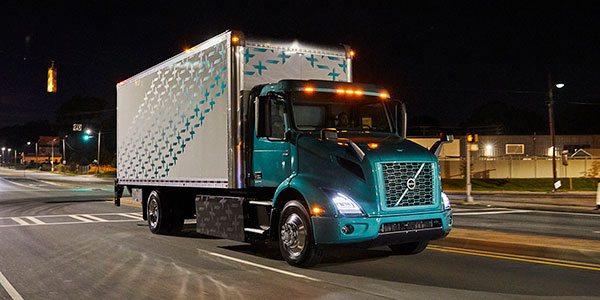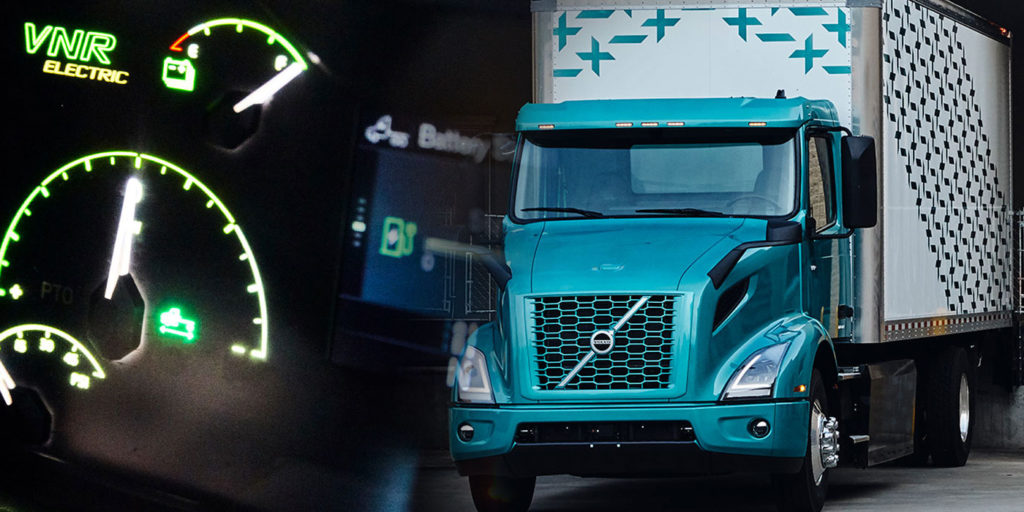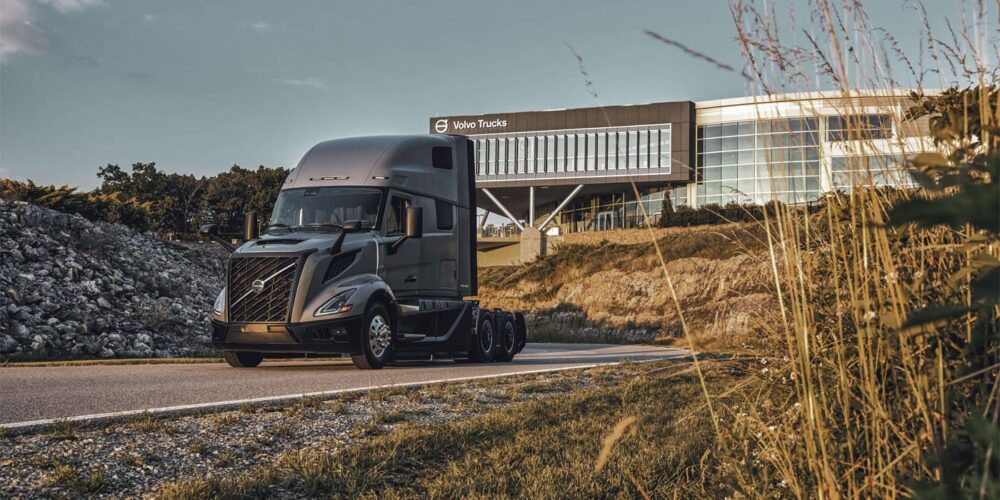Volvo Trucks North America has spent the better part of the past two years learning what it takes to run electric trucks through its LIGHTS program–a partnership between the Volvo Group, California’s South Coast Air Quality Management District (SCAQMD), and industry leaders in transportation and electrical charging infrastructure. So when the OEM announced that orders were open for the Volvo VNR Electric regional haul truck, the executive team was ready to face industry journalists’ questions. And we had plenty.
The executive roster included:
• Peter Voorhoeve, president of Volvo Trucks North America;
• Mark Curri, Volvo Trucks North America’s senior vice president of uptime and customer support;
• Brett Pope, director of electric vehicles at Volvo Trucks North America
Let’s get to the questions.
What’s going to help speed up electric truck adoption?
Voorhoeve: There are a couple of factors that are very important there. First of all, we look at those geographical areas in North America where there are good reasons to start with electric vehicles. That also needs to be supported with an incentive structure. The depreciation of electric trucks, especially now in the beginning regarding asset value, is higher than diesel trucks. In order to gain momentum, we need to have an incentive structure that helps us to take that initial step to accelerate into an electric transport environment.
At the same time, we also need to look at infrastructure, including customers and dealers who are interested in electric vehicles. We need to talk with the utility companies because getting the chargers on site and getting permits takes some time. Then, of course, and this may be the most important thing: companies that have a sustainability agenda will drive and lead the journey towards electromobility and towards zero-emission transport solutions.
What’s the aftermarket’s role in supporting electric trucks?
Curri: The first thing we have to remember is that the VNR Electric is still a VNR; it’s still the great platform that we’re familiar with. We tried to make it as simple and seamless for both our dealers and customers to service and maintain the new VNR Electric. To that end, we are offering the new Volvo Gold Contract, and part of that includes the preventative maintenance, scheduled maintenance repairs as well as our uptime services bundle. That comes standard with the Volvo VNR Electric and is configurable and customizable for the customer’s needs; the duration of the contract is intended to suit the customer.
We have to act like consultants to some extent—to match the truck with the right application and right customer and to get the dealers up to speed to support the new product. We’re prepared to do that.
Will you be continuing the trend of vertically integrated powertrains with your electric trucks?
Pope: For the driveline, absolutely. I think that’s one of the benefits of Volvo Trucks being part of the larger Volvo Group is that we do have a platform, and that platform will build such things as the transmission. We build our I-Shift transmission for diesel powertrains, and now we have a two-speed Volvo I-Shift for the VNR Electric and we’ll continue with proprietary solutions for the product.
What’s the expected life cycle of the batteries, and how easy will they be to replace at the end of their life cycle?
Pope: We design them for at least eight years on nominal usage before we’ve gone into really in-depth conversations with the customers in their actual duty cycles.
Curri: As far as servicing them, our dealers will be trained and equipped to be able to service them. What that would look like in practice is a service bay where you would work on a VNR Electric that may need extra space on the sides to be able to access the batteries and to be able to bring lifting equipment in to lift the batteries off the chassis should the need arise. Again, we offer the Volvo Gold Contract to make sure that those components and other components in the energy storage system are covered for the duration of that contract.
How will dealers be able to sell and support the VNR Electric?
Pope: It’s important to start the conversations with the dealers that show an interest because there are some things that are different. There will be investments required at the dealership in order to be able to support trucks and to make sure we have that premium experience for our customers. So I think it’s on the dealers to take the opportunity to learn where it would fit into your customer base, how you would approach that market, and how you can help drive interest in sustainability objectives for customers in the area.
Voorhoeve: We have a rigorous process as well for certifying dealers, so they are able to best take care of their customer’s needs.

Can you tell us more about the planning, permitting and installations of infrastructure?
Pope: Within the Volvo LIGHTS project, one of the findings that we had is it’s now more than just a truck: It’s the whole transport solution from end to end. We have to have partnerships and relationships with charging supplier companies. We walked through that with the customers to understand what their starting point is, what their site looks like, what’s required, and then certainly with Volvo Financial Services and the finance packages, we can work to make arrangements to make it scalable for the customer’s solutions.
Voorhoeve: One thing that we advise everybody to think about is starting time. Going from the application for a charging station to the final installation of the box to switching on the power takes time. We learned that in the Volvo LIGHTS project—it’s very good to start early.
What challenges did you encounter within the LIGHTS project in balancing the charging strategy and duty cycles of fleets involved?
Pope: Early on we started discussions with the customers about their application: What are their daily routes? We have tools that let us simulate the route to see what it would take. Can you do it on one charge? Do you need to take an opportunity charge during a mid-day break or second shift? Of course, there has to be some willingness that certain routes may need to be modified. Again, it’s a consultative approach. We work with the customer to make sure it fits into the logistics of their day-to-day operations and make sure we prove everything out before we start.
To what extent does cold weather affect the operating range?
Pope: These are lithium-ion batteries. The environmental conditions can impact the chemistry and the production of electricity for propulsion energy. What we’ve done to mitigate that impact is that we have a glycol circuit that circulates throughout the entire truck—it goes to the batteries, to the motor and the other components—so that we can precondition the truck. If it’s cold and has sat out all night while it’s being charged, it will add heat to the system so that we maintain that battery in the desired temperature range. Certainly, cold will reduce the amount of energy available, but we’ve worked hard to mitigate that type of impact with the weather conditions or environmental temperature conditions.
Are things like axle ratios and turning radius identical between the electric and conventional diesel trucks?
Pope: If you look at the specifications on the current diesel VNR, it has a tight turning radius, class-leading visibility and the safety features and active safety packages that carry straight into the VNR Electric. Specific to axle ratios, there’s a couple of options available depending on what the customer’s needs are so that we’re able to optimize that solution in order to make them successful.
Voorhoeve: You can see a bit of our development philosophy, right? By utilizing our outstanding internal research and development team, we’ve taken the well-proven Volvo VNR chassis and installed the new electric driveline into the existing platform. By doing that, the transition for the driver is easy because it’s a working environment he or she is familiar with, it’s an environment that is tested, it’s an environment that has proven its productivity and its value for our customers. All of the great features we have in our products today are carried over to the new Volvo VNR Electric truck. It’s basically the same truck, just a different driveline.
Want more details on the VNR Electric? Listen to our podcast with Volvo Trucks North America’s Brett Pope below.














